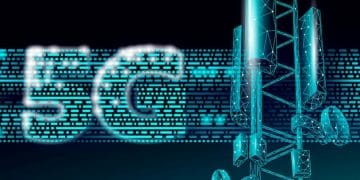Blockchain Technology & US Elections: Can It Prevent Voter Fraud?

Applying blockchain technology to US elections offers a strong potential to enhance security, transparency, and auditability, critically addressing concerns about voter fraud and ensuring electoral integrity through immutable records and cryptographic security measures.
The integrity of democratic processes hinges significantly on the perceived fairness and security of elections. In the United States, discussions around voter fraud and election security are perennial, often intensifying during electoral cycles. A novel solution frequently proposed to bolster this trust is the integration of blockchain technology in US elections: can it prevent voter fraud? This article explores the potential and limitations of adopting blockchain in the electoral landscape.
understanding election security challenges in the US
Ensuring the security and integrity of elections presents a complex challenge, one that systems across the United States grapple with continuously. Multiple layers of vulnerability exist, from voter registration databases to the actual casting and counting of ballots. The decentralized nature of US elections, with distinct regulations and procedures across states and even counties, multiplies these complexities. Identifying and mitigating these vulnerabilities is paramount for public trust.
current vulnerabilities in US election systems
Current election systems, while generally robust, are not without their weaknesses. These can range from human errors to sophisticated cyberattacks. Paper-based systems, while offering a tangible audit trail, can be susceptible to mishandling or targeted destruction. Electronic voting machines, especially those without paper trails, raise concerns about verifiability and potential manipulation. The sheer volume of data, from voter rolls to precinct results, creates numerous points where discrepancies or malicious activities could go unnoticed. Each administrative level, from local to federal, carries unique security responsibilities, leading to a patchwork of varying security standards. This variability can unintentionally create softer targets for those seeking to undermine election outcomes.
Some key areas of concern include:
- Voter Registration Databases: These are often centralized, making them attractive targets for cyberattacks aimed at manipulating voter rolls, adding or removing eligible voters, or altering addresses.
- Voting Machines: Electronic voting machines vary widely in their design, transparency, and auditability. Some legacy machines lack crucial security features, including robust paper trails, making recounts difficult and casting doubt on results.
- Ballot Chain of Custody: Tracking paper ballots from printing to counting can be complex. Any break in the chain of custody can lead to suspicions of tampering or loss, undermining the integrity of the process.
- Human Error and Insider Threats: Mistakes by election officials, whether accidental or intentional, can compromise election integrity. Insider threats, though rare, pose a significant risk due to privileged access to sensitive systems.
Beyond the technical vulnerabilities, there’s also the challenge of public perception. Even if systems are secure, a lack of transparency or clear communication can erode public trust. Disinformation campaigns, foreign interference, and partisan rhetoric can exacerbate these fears, regardless of the factual basis. This perception challenge underscores the need for not just secure systems, but systems that are undeniably transparent and auditable. Building trust requires demonstrating security, not just asserting it.
While robust measures are in place to counteract these threats, the evolving nature of cyber threats and the political climate demand continuous innovation and adaptation. This is where technologies like blockchain emerge as potential game-changers, offering new paradigms for security and transparency that could address some of these fundamental challenges. The next section delves into the core principles of blockchain and how they might apply to the unique demands of election security.
what is blockchain and how does it work?
Blockchain technology, often associated with cryptocurrencies like Bitcoin, is fundamentally an immutable, distributed ledger system. It operates as a continuous list of records, called blocks, linked and secured using cryptography. Each block contains a cryptographic hash of the previous block, a timestamp, and transaction data. This interlocking structure makes it incredibly difficult to modify or tamper with recorded information retrospectively. Once data is added to the blockchain, it cannot be altered or removed without affecting subsequent blocks, which would be immediately detectable by the network.
core principles of blockchain relevant to elections
Several intrinsic properties of blockchain make it an intriguing candidate for enhancing election security. These principles directly address many of the vulnerabilities found in traditional election systems, offering a new approach to ensuring data integrity and transparency. The decentralized nature, coupled with cryptographic security, creates a robust framework potentially capable of withstanding various forms of attack or manipulation.
The most critical aspects are:
- Decentralization: Instead of a single, centralized database, a blockchain ledger is distributed across a network of computers. This means there’s no single point of failure or attack; for information to be altered, a majority of the network participants would have to agree to the change, which is practically impossible for widespread malicious activity. In an election context, this could mean voter records and ballot data are hosted on numerous independent nodes, making hacking across the board extremely difficult.
- Immutability: Once a transaction (or a vote) is recorded on the blockchain, it becomes a permanent part of the ledger. Each new block contains a unique digital fingerprint of the previous one, forming an unbreakable chain. Any attempt to alter an old record would invalidate the subsequent blocks, immediately signaling tampering to all participants on the network. This property directly addresses concerns about voter rolls being altered or ballots being changed after casting.
- Transparency: While individual voter identities can be anonymized, the transactions themselves are openly viewable by all participants on the network (depending on the type of blockchain, public or private). This allows for unprecedented auditability, where anyone can verify that votes have been accurately recorded and counted without revealing personal voting choices. This level of openness could significantly enhance public trust by making the entire process transparent and verifiable.
The cryptographic security underpinning blockchain ensures that each transaction is verified and secured. This involves complex algorithms that secure the data links between blocks, making it computationally infeasible to reverse-engineer or forge. Furthermore, the consensus mechanisms employed by blockchains ensure that all participants agree on the validity of new entries before they are added to the ledger, preventing fraudulent data from being accepted by the network. This collective verification adds another layer of security, as no single entity can unilaterally dictate the state of the ledger.
This combination of decentralization, immutability, and transparency presents a compelling case for exploring blockchain’s application in high-stakes environments like elections. Its ability to create unalterable records accessible for audit could revolutionize how election integrity is viewed and maintained, moving beyond traditional security measures to a more inherently verifiable system. However, the theoretical benefits must be weighed against practical challenges and potential drawbacks, which we will explore in subsequent sections.
how blockchain could prevent voter fraud
The inherent properties of blockchain technology offer several compelling ways to address and potentially prevent various forms of voter fraud. By transforming how voter registration, ballot casting, and vote tabulation are managed, blockchain could introduce unprecedented levels of security and transparency into the electoral process. The core idea is to create an unforgeable, transparent record of every action, making fraud attempts immediately detectable.

potential applications for election integrity
One of the most significant applications lies in securing voter registration. Currently, voter rolls can be vulnerable to manipulation, such as the registration of ineligible voters or the double-registration of individuals. With blockchain, each voter’s registration could be a unique, cryptographically secured entry on a distributed ledger. This would make it incredibly difficult to create fake registrations or register multiple times, as any attempt would clash with existing, immutable records, triggering an immediate alert. The system could also inherently prevent eligible voters from being removed en masse, as such an action would be transparently visible and irreversible without consensus.
Furthermore, blockchain offers a robust solution for securing the casting and counting of votes. Each valid ballot could be recorded as a transaction on the blockchain. Once a ballot is cast and recorded, it becomes part of the immutable ledger, preventing any alteration or deletion. This eliminates the possibility of physical ballot tampering, shredding, or changing votes after they have been cast. While maintaining voter anonymity, the system could allow observers to verify that every cast ballot has been accurately recorded and counted. This provides a transparent audit trail from ballot to final tally, significantly reducing concerns about miscounted or manipulated results.
Key benefits include:
- Secure Voter Registration: Each registered voter would have a unique, cryptographically secured entry on the blockchain, making duplicate registrations or fraudulent additions nearly impossible. Changes would be transparent and auditable.
- Immutable Ballot Records: Once a vote is cast and recorded as a transaction on the blockchain, it cannot be altered or removed. This ensures the integrity of individual ballots from casting to counting.
- Enhanced Transparency and Auditability: The distributed nature means every valid participant could view the ledger, verifying that all votes cast are counted and no votes are added or removed fraudulently, all while preserving voter anonymity through cryptographic methods.
- Prevention of Double Voting: With a secure record of who has voted, the system could inherently prevent individuals from casting more than one ballot, even across different precincts or states, by flagging unique voter IDs.
The prevention of double voting is another critical area where blockchain shines. By recording each “voted” status as an immutable transaction tied to a unique (though anonymized) voter ID, the system could automatically prevent any subsequent attempts by the same individual to cast another ballot, anywhere in the country. This real-time validation across a distributed ledger would make double voting virtually impossible to execute undetected. The transparent nature of these records would also deter such attempts, knowing that every action leaves an indelible mark.
Finally, blockchain’s potential extends to the post-election audit process. With every vote immutably recorded, audits become significantly more straightforward and trustworthy. Recounts could involve simply re-aggregating the verifiable data on the blockchain, reducing human error and increasing confidence in the final results. The public could even participate in the auditing process, verifying statistical counts against the transparent ledger, further cementing trust. This robust auditability transforms the election process from a black box into a transparent, verifiable operation, rebuilding trust in outcomes by offering undeniable proof.
challenges and limitations of blockchain in elections
Despite its theoretical advantages, the implementation of blockchain technology in US elections faces significant practical, technical, and social hurdles. These challenges are not trivial and require careful consideration before any widespread adoption could occur. The complexity of electoral systems, coupled with public skepticism and the need for significant infrastructure overhaul, make rapid deployment unlikely.
technical, practical, and social hurdles
One of the primary technical challenges revolves around scalability and speed. US elections involve millions of votes cast in a very short timeframe. Current blockchain technologies, particularly public ones, can struggle with the transaction volumes and processing speeds required for a national election. While private or permissioned blockchains might offer better performance, they introduce concerns about decentralization and who controls the network, potentially undermining the very transparency blockchain aims to provide. Another technical hurdle is ensuring robust cybersecurity for the blockchain itself, as well as the interfaces voters would use. While blockchain is inherently secure, the systems built around it can remain vulnerable.
From a practical standpoint, the cost and infrastructure requirements are substantial. Implementing a nationwide blockchain voting system would necessitate a massive investment in new hardware, software, and training for election officials. This transformation would touch every precinct and state, requiring years of planning, development, and phased rollout. Furthermore, the varying regulations and current technological capabilities across hundreds of election jurisdictions present a complex integration nightmare. Reaching consensus among states and ensuring interoperability would be an immense undertaking, potentially stifling widespread adoption due to disparate existing systems and legal frameworks.
Cost considerations include:
- Infrastructure Investment: Significant capital would be required to procure new hardware, develop custom software, and establish highly secure network infrastructure compatible with blockchain protocols.
- Training and Education: Election officials and poll workers nationwide would need extensive training on new systems, processes, and security protocols, a costly and time-consuming endeavor.
- Maintenance and Upgrades: Like any complex technological system, a blockchain voting platform would require continuous maintenance, security updates, and upgrades, incurring ongoing operational costs.
Social and political hurdles are perhaps the most formidable. Public trust in new election technologies is already fragile, and the perceived complexity of blockchain might exacerbate rather than alleviate these fears. Some may view it as an attempt to introduce additional layers of technological obscurity rather than simplification. There are significant concerns about voter anonymity, especially if the distributed ledger reveals any information that could be linked back to individual votes, even indirectly. Ensuring complete anonymity while maintaining transparency is a delicate balance. Furthermore, the political will to enact such a monumental shift is often lacking, given the partisan nature of election reforms and inherent resistance to change within established bureaucratic systems.
Another significant concern is the “human element.” Even with a perfect blockchain system, the interfaces through which voters interact with it must be secure, user-friendly, and accessible. If voters find the system too complicated or untrustworthy, adoption rates could be low, and concerns about disenfranchisement for less tech-savvy populations could arise. Moreover, the initial entry points for data—registration and ballot marking—are still susceptible to human error or manipulation, even if the ledger itself is immutable. The principle of “garbage in, garbage out” still applies. Addressing these multi-faceted challenges requires not just technological prowess but also profound societal and governmental consensus and careful, transparent implementation.
case studies and pilot programs
While widespread adoption of blockchain technology in US elections remains a distant prospect, several smaller-scale case studies and pilot programs have been initiated, offering valuable insights into its potential and challenges. These limited deployments have primarily focused on specific aspects of the voting process, such as absentee voting for military personnel or small-scale municipal elections. They serve as experimental grounds to test the practicalities and identify unforeseen issues that arise during implementation.
lessons learned from real-world implementations
One notable example is the use of blockchain for military and overseas voters. West Virginia pioneered a mobile voting application, Voatz, that utilized blockchain technology for secure absentee voting during the 2018 and 2020 elections. The idea was to mitigate issues such as lost ballots, extended mailing times, and difficulties in verifying voter identity for service members abroad. While the pilot was praised for its aims, it also faced significant scrutiny, particularly from cybersecurity experts who identified potential vulnerabilities in the app and the underlying technology, raising questions about its readiness for broader use. These concerns highlighted the need for rigorous, independent security audits and transparent protocols.
Another instance involved several smaller municipalities exploring blockchain for municipal elections. These pilots often aimed to increase voter turnout by offering mobile voting options while ensuring the integrity of the process. While some reported positive feedback on the user experience, scalability remained a key concern. The relatively low voter numbers in these local elections do not accurately reflect the immense data processing demands of state or federal elections. Moreover, the pilots underscored the necessity of robust identity verification mechanisms integrated with the blockchain, as the anonymity desired in election results must not compromise the integrity of voter identity.
Lessons learned from these pilot programs are crucial for future evaluations. They often reveal that integrating complex technologies into existing electoral infrastructures is far more challenging than anticipated. The need for a harmonious blend of technology, legal frameworks, and public acceptance became evident. Key takeaways include:
- Security Audits are Paramount: Pilot programs, especially the West Virginia example, showed that even well-intentioned applications can have vulnerabilities. Thorough, independent, and continuous security audits are essential before scaling up.
- Scalability Limitations: Most current blockchain platforms struggle with the transaction volume of large-scale elections. Solutions are needed to handle millions of simultaneous votes without compromising speed or integrity.
- Voter Education and Trust: Without comprehensive voter education campaigns and demonstrable transparency, public skepticism about new technologies, particularly blockchain, remains a significant hurdle.
- Regulatory Frameworks: Existing election laws are not designed for blockchain voting. Significant legal reforms and consensus-building would be necessary to accommodate such systems nationally.
These real-world examples, despite their limited scope and sometimes mixed results, provide invaluable data for policymakers and technologists. They demonstrate the tangible benefits, such as increased accessibility for specific voter groups, but also starkly highlight the profound technical, logistical, and trust-related challenges that must be overcome. The path forward for blockchain in elections will likely involve more targeted, well-audited pilots, focusing on specific problems, rather than a sweeping overhaul of the entire electoral system in the near term. The cautious approach taken so far reflects the high stakes involved in safeguarding democratic processes.
the future of election technology: integration or revolution?
The trajectory of election technology in the United States stands at a pivotal juncture. The question isn’t solely about whether blockchain will be adopted, but rather how new technologies, including blockchain, will integrate with or potentially revolutionize existing electoral frameworks. This involves a careful balancing act between innovation, security, accessibility, and public trust, all within a politically charged environment. The future could see a gradual integration of blockchain functionalities into specific areas of election administration, or it could witness a more radical, albeit distant, shift towards entirely blockchain-based voting systems.
predicting blockchain’s role in US elections by 2025 and beyond
By 2025, it is unlikely that blockchain will be widely implemented for direct voter casting in US federal or state elections. The technical, security, legal, and social hurdles are simply too substantial to overcome within such a short timeframe for mass adoption. Instead, we are more likely to see continued small-scale pilot programs, perhaps focusing on niche applications like securing absentee ballot requests, tracking election equipment, or auding supply chains for voting materials. These incremental uses would allow for further testing, refinement, and a gradual build-up of public and governmental confidence in the technology’s capabilities. The emphasis will remain on ensuring absolute security and auditability before any large-scale direct voter application.
Looking beyond 2025, the picture becomes more speculative. If the technological barriers around scalability and privacy can be overcome, and if robust, independently verified cybersecurity standards can be established, blockchain might play a more significant role. It could move from behind-the-scenes applications to parts of the voting process visible to the public. For instance, blockchain could be used to create an immutable log of ballot counts at the precinct level, which then feeds into a statewide tally. This would provide transparent, verifiable checkpoints throughout the tabulation process without necessarily relying on blockchain for remote voting.
Potential future scenarios depend heavily on:
Regulatory Adaptations: The establishment of clear legal frameworks and national standards for blockchain in elections would be critical. This requires cross-partisan agreement and a willingness to modernize electoral law.
Public Trust and Education: Overcoming public skepticism through transparent pilots, extensive voter education, and demonstrable security will be paramount. Without public trust, even the most secure system will face backlash.
Cybersecurity Resilience: Continuous improvement in defending against sophisticated cyber threats, both for the blockchain itself and the systems interacting with it, is non-negotiable.
A more revolutionary shift towards entirely blockchain-based voting systems, where every vote is cast and secured on a distributed ledger, remains a long-term vision, possibly decades away. This would require a fundamental paradigm shift in how elections are administered, moving away from existing infrastructures that have been built and refined over centuries. The transition would demand immense resources, a complete re-evaluation of election laws, and a collective societal consensus on the benefits versus the risks. The cautious approach is favored due to the inherent value of electoral integrity to democratic stability. Thus, the future of election technology will likely prioritize integration of proven, secure blockchain components within existing systems over a rapid, widespread revolution. The journey will be iterative, marked by careful experimentation and adaptation, always with an unwavering focus on integrity and public confidence.
reconciling security, accessibility, and public trust
The ultimate success of any electoral technology, especially one as transformative as blockchain, hinges on its ability to reconcile three critical, sometimes conflicting, objectives: security, accessibility, and public trust. A system that is immensely secure but inaccessible to many voters, or one that is widely accessible but lacks public confidence due to transparency concerns, ultimately fails in its primary purpose of facilitating fair and legitimate elections. Achieving this balance is the central challenge for integrating blockchain into election systems.

the delicate balance for democratic integrity
Security, the cornerstone of any election system, involves protecting against fraud, manipulation, and cyberattacks. For blockchain, this means ensuring the integrity of the ledger, the cryptographic keys, and the interfaces. However, excessive security measures, if poorly implemented, can inadvertently create barriers to accessibility. For instance, overly complex digital identity verification processes could disenfranchise voters who lack the necessary technology or digital literacy. The goal is to build a system that is robust against sophisticated threats while remaining simple and intuitive enough for all eligible citizens to use. This often requires innovative design that abstracts much of the underlying blockchain complexity from the user.
Accessibility encompasses ensuring that all eligible voters, regardless of physical ability, technological proficiency, location, or socioeconomic status, can cast their ballots easily and securely. This includes considerations for voters with disabilities, elderly populations, rural communities with limited internet access, and overseas military personnel. Traditional paper ballots, for all their drawbacks, offer a widely understood and accessible method. Any blockchain-based system must prove it can match or exceed this level of accessibility, perhaps by offering multiple secure pathways for participation, combining digital and physical components, or providing robust tech support and voter education. The digital divide remains a significant hurdle that must be actively addressed.
The most challenging objective might be fostering and maintaining public trust. Elections are not merely technical exercises; they are profound acts of civic participation where the perceived legitimacy of the outcome is paramount. Even a perfectly secure and accessible system will fail if the public does not trust it. This calls for unprecedented levels of transparency, clear communication about how the technology works, and independent oversight. Blockchain’s inherent transparency can be a powerful tool here, allowing for external audits and public verification of vote counts (without revealing individual choices), but it requires careful explanation to a varied audience.
To strike this delicate balance, future developments might involve:
- Hybrid Systems: Instead of a complete overhaul, combining the best of traditional and blockchain technologies, perhaps using blockchain for secure ballot tabulation while retaining familiar paper trails for voter verification and audits.
- Phased Implementation: Rolling out new technologies in small, manageable pilots, gathering feedback, addressing concerns, and gradually scaling up, rather than a big-bang approach that could erode trust.
- Robust Education Campaigns: Proactive, clear, and non-partisan public education on how new technologies work, their security features, and how they protect the integrity of the vote.
- Independent Oversight and Audits: Establishing strong, non-governmental bodies to independently audit and certify the security and functionality of blockchain-based election systems, providing unbiased validation.
Ultimately, the integration of blockchain into US elections, if it happens, will be a testament to a deliberate, thoughtful process that prioritizes the core tenets of democracy. It will require a commitment to innovation tempered by caution, an openness to public scrutiny, and a relentless focus on ensuring that every eligible voice can be heard, counted, and verified without question. The path forward is not just technological, but fundamentally civic, requiring broad consensus and shared commitment to democratic integrity.
| Key Aspect | Brief Description |
|---|---|
| 🔒 Data Security | Blockchain’s immutability and cryptographic security make voting records highly resistant to tampering. |
| 📊 Transparency & Auditability | Distributed ledgers offer unparalleled transparency, allowing for verifiable and auditable vote counts. |
| ❗ Challenges | Scalability, cost, regulatory hurdles, and public trust remain significant barriers to widespread adoption. |
| 🔮 Future Outlook | Likely incremental integration into specific election processes rather than immediate, full-scale revolution. |
frequently asked questions about blockchain and elections
While blockchain significantly enhances security and auditability, no system can guarantee 100% fraud prevention. Vulnerabilities can still exist at the input stage (e.g., identity verification) or through the user interface. Blockchain addresses ledger tampering exceptionally well, but human error or external exploits remain possibilities.
Blockchain systems for voting typically employ cryptographic techniques to separate voter identity from their ballot. Votes are recorded as anonymous transactions, linked to a unique but untraceable identifier, ensuring that while the vote is verifiable on the ledger, it cannot be tied back to an individual voter.
While the decentralized nature of blockchain makes it highly resistant to single-point attacks, the systems built around it (e.g., voter registration, ballot casting interfaces) could still be targeted. Robust cybersecurity measures for these external components are crucial, alongside the inherent security of the blockchain itself.
Current public blockchain technologies generally face scalability challenges under the immense transaction volume of a national election. While private or permissioned blockchains offer better performance, they spark concerns about decentralization. Further technological advancements are needed to address this for large-scale federal elections.
The biggest hurdle is arguably public trust, coupled with the complex legal and regulatory landscape. Overcoming skepticism about new technologies and building consensus among diverse political stakeholders are more challenging than the technical hurdles. Significant voter education and transparent development are essential.
conclusion
The exploration of blockchain technology in US elections: can it prevent voter fraud? reveals a complex interplay of promising potential and significant challenges. While blockchain’s core principles of decentralization, immutability, and transparency offer compelling solutions to many long-standing concerns about election security and fraud, its widespread adoption remains an ambitious endeavor. The journey forward will likely involve careful, incremental steps, focusing on targeted applications where blockchain can demonstrably enhance integrity without compromising accessibility or public trust. As technology evolves and understanding deepens, blockchain may indeed play a crucial role in safeguarding the future of democratic processes, building systems that are not just secure, but undeniably transparent and verifiably fair.





